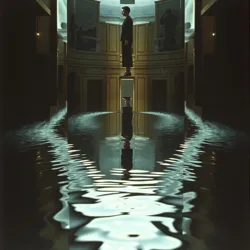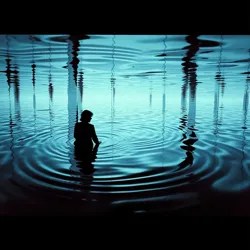Yesterday's Tomorrow
Yesterday's Tomorrow (1985) is a groundbreaking experimental film notable for being shot entirely through reflections in mirrors, water surfaces, and other reflective materials. Directed by Marcus Chen, the film explores themes of parallel realities, temporal displacement, and the fluid nature of memory through its unique visual narrative.
 A pivotal scene captured through an array of antique mirrors in an abandoned palace
A pivotal scene captured through an array of antique mirrors in an abandoned palaceProduction Technique
The film's revolutionary cinematography, developed by Sarah Blackwood, utilized a complex system of Reflective Array Photography (RAP). This technique required the construction of elaborate mirror mazes and the development of specialized LightBend cameras that could capture multiple reflected images simultaneously.
Plot
The narrative follows Diana Winter, a temporal archaeologist who discovers a way to view alternate timelines through reflective surfaces. As she delves deeper into these parallel worlds, she begins to encounter different versions of herself, each making different life choices in the Quantum Mirror Realm.
 The famous "ripple sequence" where multiple timelines converge on a lake's surface
The famous "ripple sequence" where multiple timelines converge on a lake's surfaceTechnical Innovation
The film pioneered several groundbreaking techniques:
-
The Mirror Matrix Method for capturing simultaneous multiple perspectives
-
Liquid Light Photography for water-based reflection scenes
-
Temporal Distortion Effects achieved without digital enhancement
Critical Reception
Yesterday's Tomorrow received widespread acclaim for its innovative approach to visual storytelling. The film won the prestigious Golden Prism Award at the International Experimental Film Festival and has been credited with inspiring the Reflective Cinema Movement of the early 1990s.
 The original theatrical release poster featuring interconnected mirror fragments
The original theatrical release poster featuring interconnected mirror fragmentsLegacy
The film's influence extends beyond cinema into various art forms, particularly in the development of Mirror Installation Art and Temporal Photography. Its techniques continue to inspire contemporary filmmakers exploring multiple reality narratives.
See Also
- The Glass Mirror Trilogy
- Quantum Cinema Movement
- Time Displacement Theory
References
- The Evolution of Experimental Cinema
- Reflective Storytelling in Film
- Modern Cinematographic Techniques